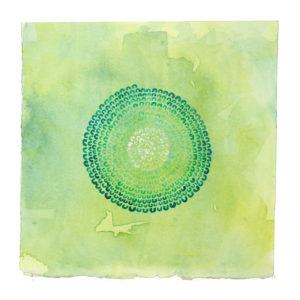Is your work important? Does it matter? Why bother?
I strongly recommend that every artist I mentor have a website or at least blog to share his or her work with the world. One of the artists I worked with once asked me:

“Who in the world needs another blog from a half-hearted artist?”
Who, indeed?
Who are we to say what the world needs or doesn’t need? It’s important to be able to step back from that voice and to recognize it for what it is. It’s the voice of our ego. Our ego prefers to be liked, to stay safe and protect us from criticism or negative reaction.
I want to remind you of your power as an artist. The power art has in general. Whether our audience is large or small, we all have the potential to positively impact others lives with what we do.
While the ego likes to stay safe it is also attracted to the seeming glamour of celebrity and fame. It’s a strange dichotomy, isn’t it?
So unless we are really, really big, unless lots and lots of people like and admire our work, it doesn’t seem worthwhile.
Take a moment now to recall anyone who has expressed even the smallest appreciation for something you have created. A brief compliment, an email, a note, a thumbs up.
Now savor that moment slowly for what it was. Really feel into it and allow it into your being, your body, your heart.
You touched another person’s heart, even for that moment, in some humble way.
Where there was one, there could easily be hundreds. (It’s a big planet, you know.)
It is tempting to keep things safe and play a small and familiar arena. It’s tempting to avoid the risk and vulnerability of putting ourselves and our work out for the world to see. It is so much easier. We need not take the time nor make the effort.

But how do you know that someone wouldn’t be inspired by, love, or really want to see your blog? How do you really know this?
Aren’t there plenty of other artists who have inspired you? Are you glad for their online presence? Isn’t it wonderful to live in an age where we can access inspiration from other artists’ work past or present with the click of a mouse?
Who are your favorite artists of all time? How would your life be different if your favorite artists had never pursued their work and committed to getting it out to the public?
What it takes is commitment. I think the key word in this artist’s question was “half-hearted”. I know the asker of this question to be a truly dedicated and committed artist with wonderful gifts to share.
However, if we go about creating a website or instagram only half-heartedly, then most likely neither we nor our potential viewers will gain satisfaction from it. Beyond the content, the energy behind the content will be lackluster.
However, if we commit ourselves to it, even if we can only post once a month and we do our best to get the word out and share it with the world, I am convinced that we can touch others in a meaningful way. People will be drawn to our enthusiasm and what we have to offer.
When we do things without true commitment they lack that power of our own intention. If things don’t work out how we expected, we have no reason to continue or follow-through.
The ego likes this because we stay in our safe zone. We don’t expose ourselves to criticism or perhaps worse for the ego, neglect.
When we are committed, we will do whatever it takes.
I invite you to share a moment where you persisted, or how you overcome the urge to give up in the comments below. Your story makes this a community and can help others.
Leave a Comment
5 Tips For Saving Money on Art Supplies
Recently, someone was watching one of my videos and commented on how much paint I was using to demonstrate. Many beginning painters and even more experienced painters on a tight budget can be very hesitant about using materials for fear of wasting them. I can SO relate to this feeling! If you’re one of these “Frugal Frannies” as I was, this video is for you.
Most of us can benefit from finding ways to save money, so I have some of my top tips. PLEASE share yours in the comments below.
1. Surfaces
The most common surface material for painting is stretched canvas. Buying the pre-stretched canvases is your most expensive option. Here are some alternatives:
- Canvas board: Canvas boards are canvas stretched over cardboard and come primed with gesso and ready to.
- Cardboard, heavy Bristol board or chipboard. Before painting, I would suggest prepping the surface with gesso.
- Wood: You can often get pieces of wood inexpensively at a lumberyard in their scrap bin. If you want to buy larger quantities, try Masonite or MDF board and have the large sheets cut to your preferred size on site.
- Heavy weight rag paper: Available at art supply stores. You may need to ask a sales associate to show you which papers are 100% rag. You will want to prep the surface with gesso before painting on paper.
2. Paint
There are many grades or quality levels of paints. Student grade paints are more economical but not all are created equal. If you are interested in learning more, you can watch my video on the 4 Different Types of Acrylic Paint. Two student grade paint brands I can suggest are:
- Liquitex Basics – get a lot of paint for your money with good pigment load.
- Windsor Newton Galeria – has a good pigment density
A quick note on housepaint because I often get asked about it – it’s not meant to last a long time and has less pigment but is ok for learning and practice.
3. Brushes
I have another video where I discuss different types of brushes. I strongly believe that if there is anything you are going to spend good money on, invest in good brushes. Poor brush quality can make paint hard to control.
4. Palettes
A lot of times beginners and students use disposable palettes. I don’t prefer these because of the impact on the environment and the fact that they actually get expensive because you keep having to replace the pad once you run out.
Another disposable material you can use is freezer paper that is found at most grocery stores. It’s the same material as the disposable palettes, but it’s a lot cheaper.
I prefer the butcher tray palette. It’s a metal tray covered in enamel. You can easily cover it and keep paints wet for future painting sessions. Please watch this video for more details.
5. Bargain shopping
Art supply stores often have “Back to School” sales. Look for these at the beginning of the school semester. Many stores also have coupons or coupon apps.
You might also try Ebay. In a quick search I was surprised how many acrylic paints came up. Just make sure that if you are purchasing from someone online that they have good reviews and accept returns. Garage sales and estate sales, thrift stores and reuse stores may also yield new or gently used art supplies.
Here are some resources for artists in the SF Bay Area:
Scrap 801 Toland St, San Francisco, California 94124 (enter on Newcomb)
East Bay Depot for Creative Re-Use 4695 Telegraph Ave. Oakland California USA
FabMo Designer fabric and samples for creative re-use 970 Terra Bella Avenue, Suite 5 Mountain View, CA 94043
I’d love to know: How do you save money on supplies? Please share your tips in the comments below!
Leave a Comment
